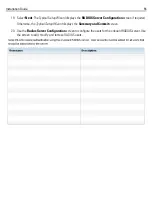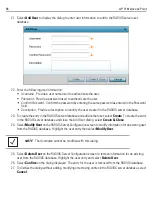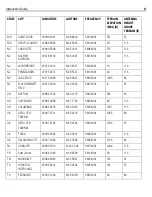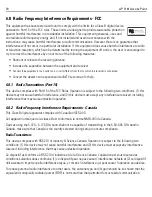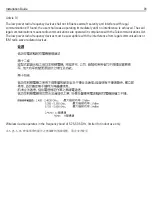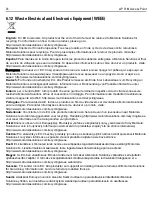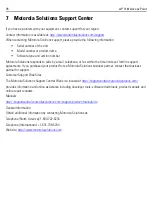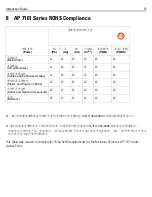
64
AP 7161 Access Point
1
The devices subject to the requirements in this KDB can select the initial channel for operation to avoid TDWRs
and apply the Uniform Channel Spreading requirements (see FCC 06-96 in ET Docket 03-122 released June 30,
2006) on the remaining available frequency band of operation. All the other test procedures including the test
radar patterns remain the same at the present time. A revision to the measurement procedure with modification
to the Uniform Channel Spreading requirement and other changes will be released in the future. The
Commission will also address the issue of any field upgrade option at that time.
2
The grantee must identify the specific expertise and the training required by the installers for installing these
types of devices.
3
In some instances it is possible that a device may be within 35 km of multiple TDWRs. In this case the device
must ensure that it avoids operation within 30 MHz for each of the TDWRs. This requirement applies even if the
master is outside the 35 km radius but communicates with outdoor clients which may be within the 35 km
radius of the TDWRs.
4
The requirement for ensuring 30 MHz frequency separation is based on the best information available to date. If
interference is not eliminated, a distance limitation based on line-of-sight from TDWR will need to be used. In
addition, devices with bandwidths greater than 20 MHz may require greater frequency separation.
• Procedures for the installers and the operators on how to register the devices in the industry-sponsored
database with the appropriate information regarding the location and operation of the device and installer
information is included.
6
• Devices must meet all of the other requirements specified in Section 15.407, and it is prohibited to include
configuration controls (e.g. country code settings or other options to modify DFS functions) to change the
frequency of operations to any frequency other than those specified on the grant of certification for US
operation.
7
• All applications for equipment authorization must clearly show compliance with all of the technical
requirements under worst case parameters, under user or operator control, based on frame rates, listen/talk
ratios and user data transfer conditions.
All the devices subject to the DFS requirements must be submitted to the Commission’s Laboratory Division for
pre-grant testing and equipment authorization.8 The applicant must ensure that all equipment authorization
applications subject to this interim procedure include appropriate attestations that the device has no option to
change the DFS parameters and that transmissions are disabled at least in the 5600 – 5650 MHz band. The
application must include the user’s manual with the appropriate installation and operations requirements for the
installers and operators.
We are continuing to evaluate additional measures that may need to be taken to further ensure against
interference caused by 5 GHz outdoor wireless systems located near airports. While manufacturers have an
obligation to ensure that their equipment complies with FCC rules, and must take steps to ensure their devices are
unlikely to cause harmful interference, Section 15.5 of the Commission’s rules also places an obligation on users
of devices to avoid causing interference and to correct any interference that may occur.
Summary of Contents for AP 7161
Page 1: ...AP 7161 ACCESS POINT INSTALLATION GUIDE ...
Page 78: ...78 AP 7161 Access Point ...
Page 79: ...Installation Guide 79 ...






